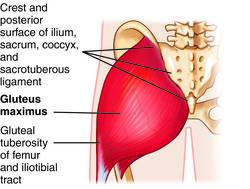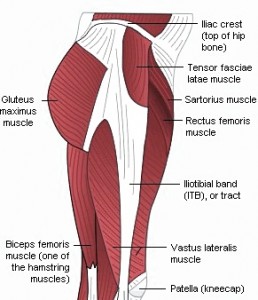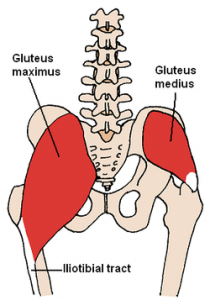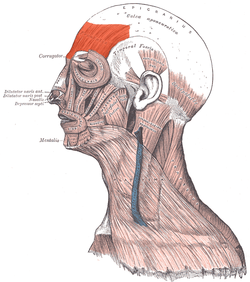Gluteus Maximus Definition
Page Contents
The Gluteus Maximus, Gluteus Medius and Gluteus Minimus, collectively referred to as the “Glutes,” are the three gluteal muscles. The Gluteus Maximus is the largest of the three. This large skeletal muscle is responsible for providing the butt with shape and helping the thigh move.
Gluteus Maximus Appearance
Picture 1 – Gluteus Maximus
The muscle has a large, thick and broad appearance. It looks like a fleshy, four-sided lump that makes up the protruded area of the buttock (nates).
Gluteus Maximus Anatomy
This muscle comprises of a fleshy mass as well as other constituents, such as:
- Inferior gluteal nerve – It is large-sized and essential for appropriate functioning of Gluteus Maximus. The nerve is responsible for transmission of information about activities performed by the muscle to the brain.
- Bursae – These are three small sacs filled with fluid which prevents grating of the muscle against the surface of the bone.
- Arteries – This muscle also comprises of the main superior and inferior gluteal arteries.
Gluteus Maximus Antagonist
The muscle works as an antagonist to the muscles like Psoas major, Psoas minor and Iliacus.
Gluteus Maximus Origin
The muscle has its origin at
- Sacrotuberous ligament
- Sacrum
- Lumbar fascia
- Gluteal surface of ilium
Gluteus Maximus Insertion
The points of insertion of this muscle are at the Iliotibial tract and the Gluteal tuberosity of the femur.
Gluteus Maximus Function
The muscle is mainly involved with lateral rotation of the upper leg and extension of the thigh at the hip. It also helps extend the pelvis that extends to the thigh. This large muscle lends support to the trunk and allows a human to stand and walk in an erect posture. Naturally, it is regarded as the strongest body muscle.
This formidable muscle supports the following functions:
- Lifting out the leg to the side
- Making the thigh extend straight at the hip
- Twisting away the thigh from the centre of the body
This is considered to be the main anti-gravity muscle that allows a person to perform various daily activities like:
- Cycling
- Running
- Squatting
- Walking up the stairs
- Jumping over ropes
The muscle can be felt in its extension phase when a person climbs up the stairs.
Gluteus Maximus Injury
An injury of this muscle is highly deceiving in nature. Gluteus Maximus injury usually gives rise to dull pain in the initial stages which gets worse with time. When injured, this muscle can affect important everyday activities like:
- Climbing up or running down stairs
- Sitting down
- Swimming
- Jumping
- Sitting for long periods on hard surfaces
If the muscle suffers a pull, it can make patients experience painful symptoms in regions like:
- Outer hip
- Lower back
- Buttocks
- Around the tail bone
Some patients also report about a burning feeling in the buttocks. When injured, the muscle should be given as much rest as possible. All activities involving it should be restricted or limited to a minimum. Injuries of this muscle usually heal on their own with rest and limitation of activities. More severe injuries require stretching and strengthening exercises.
Gluteus Maximus Exercises
The rear, or butt as is popularly known, has been regarded as one of the most vital parts of the body. A firm, well-rounded behind increases fat loss and strengthens the physique. It can boost the athletic performance of a person and help carry out daily activities much better. From an early time, various workouts have been devised to toughen the posterior and provide shape to it. The Gluteus Maximus muscle often suffers injuries during sports and athletic activities. Here are some exercises that can help strengthen this muscle and also make your butt appear more toned and attractive.
Gluteus Maximus Exercises For Men
Workouts for men and women differ based on the intensity of their performance. Generally, men have more neuromuscular efficiency and perform workouts with more explosive motion than women. Here are five great workouts that toughen the butt and make the gluteus maximus muscle more active.
Barbell Glute Bridge
This is regarded as one of the best workouts to tauten the posterior.
- Take a loaded barbell and place it on the floor.
- Sit over the floor next to the barbell.
- Fully stretch your legs right ahead.
- Roll the barbell directly over your hips.
- Bend up your knees. Make sure that your feet remain flat on the floor.
- Hold the bar alongside each hip.
- Use your heels to push the floor and raise your hips as high as you can to lift the bar every time. All through the movement, keep your upper back and heels pressed flat against the floor.
Barbell Hip Thrust
It is an advanced butt-firming workout that needs more stabilization than Barbell Glute Bridges.
- Sit on the floor beside a bench and stretch your legs right before. Make sure that the long side of the bench stays several inches behind your back. Keep a loaded barbell next to where you are seated.
- Directly roll the barbell over your hips. Bend up your knees and keep your feet flat over the floor.
- Lean back slowly to press the upper part of your back against the bench surface.
- Use an overhand grip to grasp the bar alongside each hip.
- Raise your hips in a thrusting movement to push up the bar. This should be done for every repetition.
- Press your heels into the floor and keep your back against the bench throughout the movement.
Single-Leg Hip Thrust
This is an extremely good butt-shaping workout that should ideally be performed once you can comfortably do glute bridges and barbell hip thrusts.
- Keep two benches in a position parallel to each other.
- Sit over the floor next to a bench.
- Rest your back against the bench side.
- Stretch out your arms to your sides along the bench top.
- Bend both of your knees. Keep one foot in the air. Rest the other on the second bench.
- Press the grounded foot and push up your hips. You may also place heavy plates on your hips to add more resistance.
Weighted Bird Dog
This is an excellent workout for men that toughen the butt also make the hamstrings most active.
- Get down on the floor with only your hands and knees for support.
- Hold a dumbbell in one hand. Wear an ankle weight in the opposite leg.
- Align your wrists under your shoulders and your knees under the hips.
- While you perform Step 2, lift the arm holding the dumbbell and raise the leg with the ankle weight. Continue to lift until the arm and upper-leg are in the same line as your spine.
- Hold this posture for a couple of seconds at the top of every repetition. Tighten the core muscles to make the exercise provide you with full benefit.
Gluteus Maximus Exercises for Women
These workouts help maximally activate the gluteus muscle and provide the female butt with an attractive appearance.
Quadruped Hip Extensions
Here are stepwise directions to the way you should perform this workout.
- Rest your body over your hands and knees.
- Contract your abdominal muscles slightly so as to make your spine and torso more stable.
- Raise one leg, while keeping the knee set at a right angle (90 degrees).
- Raise the leg until the point where the leg is aligned with the body and the bottom of the foot points toward the roof.
- Repeat the process on the same side for 8-12 repetitions.
- Switch the legs and perform the process again. You can try adding weights to your ankle if you want a more intense exercise session. Make sure that your head, neck and back remain completely straight as you perform the workout.
Step-Ups
This is a popular exercise that makes your gluteal muscles tougher and provides your derriere with a more shapely appearance.
- Stand behind a tall box or step (about 15 inch high) with a good posture.
- Hold a dumbbell in each hand to add more intensity to the workout.
- Put your left foot on the box/step. Place all your body weight on that leg.
- Push down with the heel of your left foot. Straighten your leg to make it rest over the box. This will take your body to the level of the box.
- Initiate the step-up using only the left leg and keeping the right leg passive. Let the right leg hang in a limp fashion.
- Repeat the process for 8-12 reps on the same side.
- Switch legs to perform the process with the other leg.
Lunges
This is a famous workout that features in any strength training exercise regimen. It targets the gluteal muscles as also the quadriceps muscles and the muscles that are part of the hamstring.
- Stand erect with good posture and keep a one-shoulder gap between your legs.
- Take a light dumbbell in each hand. This will make your workout more challenging.
- Extend the right foot and take a step forward, while keeping the spine and head straight.
- Bend your knees to make your left knee point towards the floor, but not exactly touching the ground. Ensure that the front heel points down. Also check whether the knee is directly above the middle of the foot. This will lower your body. Keep going down until the thigh is in a parallel position to the floor.
- Push down as well as forward through the heel. This will help you go back to the standing position.
- Repeat the process on the other side. Change the repetitions from 8 to 12 for each side. Add a little more weight with each passing week.
Four-Way Hip Extensions
This workout primarily targets the glutes and the hamstrings. It is usually performed in a gym with a four-way hip extension machine. Here are the steps to conduct this exercise properly.
- Stand tall with a good posture.
- Grab the stabilizing bar of the equipment.
- Place the resistance pad on the back side of the knee of the leg that you are exercising.
- Shift your thigh to a posterior position until your hip is completely extended backward.
- Repeat the process for 8-12 repetitions.
- Change sides and perform the workout again to strengthen another leg.
Gluteus Maximus Stretches
The Gluteus Maximus is involved in a number of physical activities that are performed every day. It is also needed to perform many athletic activities. Naturally, it often suffers a pull or strain. Stretches lengthen the muscle and ease the tension. This helps the muscle regain its original length.
Some of the most beneficial stretching exercises for this muscle are described below:
Gluteal Stretch
This workout targets the gluteus maximus as well as the two other muscles of the “Glutes” group (Gluteus Minimus and Gluteus Medius). It also helps stretch the piriformis muscle located deep within the buttocks and cure piriformis syndrome naturally. Here is how to perform it.
- Lie down on your face.
- Bend your right leg under the abdomen.
- Keep your left leg extended straight.
- Bend ahead at the waist. Retain this posture for 10- 30 seconds.
- Repeat the process on the other side.
Gluteus Stretch
This exercise helps lengthen the Gluteus Maximus muscle and provide relief from painful symptoms caused by Sciatica. Here are stepwise directions to performing the workout.
- Lie down on your back.
- Bend the right leg slowly to bring it up to the chest.
- Pull the right knee towards the left shoulder, using your arms.
- Retain the posture for about half-a-minute.
- Repeat the process again, this time with the left leg and right shoulder.
Gluteus Maximus Pictures
Take a look at these Gluteus Maximus photos to know how the largest muscle in the human body looks like. You may use these Gluteus Maximus images for reference.
Picture 2 – Gluteus Maximus Image
Picture 3 – Gluteus Maximus Muscle
References:
http://www.loc.gov/rr/scitech/mysteries/muscles.html
http://www.teachpe.com/stretching/gluteus_maximus.php
http://www.wheelessonline.com/ortho/gluteus_maximus
http://www.miraclesformen.com/gluteus-maximus





Thank you for posting a great information.
I just need some help to my condition.
I injured my gluteus,as a result I have no muscles tissue whatsoever in my butt,I am flat and nothing I do to rebuild muscle and I tried everything.My concern is that I need a surgery.Your input would be very much appreciated.What can I do to gain the gluteus muscles back.Thanks a lot.